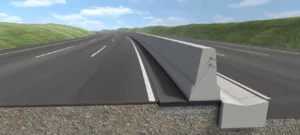Everybody knows that traffic safety barriers are there to protect us – no matter if we’re part of the pedestrian public, road workforce, or the ones driving a vehicle. We take this fact for granted, without giving much thought to the question of how exactly do these barriers provide that protection and reduce accidents and injuries. There are probably some among us who tend to think that they protect only expensive buildings and equipment since there are still many fatal car accidents and those that are worried about their relatively light-weight nature. To prevent any further ‛conspiracy theories’ of this sort, we’ve decided to put together a step-by-step explanation of how precisely these barriers work for our safety.
The Point of Impact
You don’t have to experience a car accident to understand the connection between the force with which a vehicle has hit an object and the damage that has been produced from the impact. Hollywood has filmed enough scenes where various vehicles make an impact with a variety of different object and crumble in an even greater variety of ways. All these action stunts are just the mirror of reality around us (minus the impossibilities of Tom Cruise), and it all comes down to Newton’s Second Law of Motion, where the force is equal to the mass of the object multiplied by its speed or acceleration.
Now, modern cars have fast acceleration so, when impacting in a crash, they can apply considerable force (referred to as kinetic energy) even if you’re traveling at relatively low speeds. The extent of the damage your vehicle (with you inside it) will suffer depends on the relative force of your vehicle’s crash with another object. And what traffic barriers do in order to protect and prevent is that they additionally reduce the impact of the crash.
The Deformation Response
Unlike the late 20th century cars with a solid base frame, the most of modern cars come with a design feature called ‛the crumple zone’, which has first been featured in the 1990s by Volvo’s vehicles. Basically, it is the car’s section that takes the impact at the moment of the crash and absorbs the force. What makes this process easier are the crumple zone segments of the car framework that are designed to bend and collapse into themselves, rather than remaining rigid against the object which was hit.
This might sound very painful if you imagine yourself inside the car, but these are in fact very clever safety ideas that were soon replicated into the manufacturing process, materials, and design of traffic barriers, which greatly increased their road safety effectiveness. The reason is simple – instead of rigid resistance, they are provided with a crumpling one, causing a reduction in the produced energy when a car hits the traffic barrier. And thus the new generation of barriers was created with stability in mind – the easily-movable water filled barriers, crash-tested MASS barriers, and steel barriers. Since the force that a car applies to a crash barrier depends on the car’s weight, the speed at the time of impact, and type, this was a breakthrough in barrier technology for their features are finally fit for the significant levels of force.
Slowing Down
Everybody with a driver’s license has been in a situation when you have to stop suddenly. What happens at this moment is the change from the moving speed to a sudden stationary moment. This is called the impulse and it is basically force multiplied by time. And what is important in this dramatic change of momentum when it comes to traffic safety is that time factor. If the impulse lasts longer it will cause less force to be transferred between your car and the object that’s been hit. This is where ‛the crumple zone’ achievement really shines – the very fact that both – the vehicle and the barrier – contain this safety measure allows the impulse and the force to be slowed and the damage is significantly reduced. This impulse decrease is what supports your safety by reduction of crash injuries you could have sustained.
Both Sides
Yes, the most common use of traffic barriers is to protect vehicles during road construction and repairs, but it’s still a fact that they’re also an essential protection on any roadway or area that is considered to be high risk. And this practically covers everything – speed risk on motorways and sharp bends, vehicle risk on vulnerable roadways (mainly on bridges), environmental hazard areas such as mountain roads with a possibility of landslips, and road areas where pedestrian access points and walkways are positioned in a close proximity to traffic.
In all the areas mentioned above traffic barriers not only work by just reducing the impulse and impact but they also function as a protective obstacle that prevents any vehicle from leaving the road, decreasing the possibility of a fall into various further hazards such as embankments, steep slopes or trees, and water. In these cases, the MASS Crash-Tested Barriers are most frequently used to additionally enhance the safety aspect through their specific design. The key is in their roll-on, roll-off component of design that provides them with superior stability by diverting the impact energy to their base. This stabilizes the barrier and redirects your car away, back onto the roadway. We don’t need to mention how vital this is in situations when the vehicle coming off the road is an errant one and could cause further accidents and hazards.
You had to go through some physics, but we think that there’s no more room for conspiracy theories. It can not be simpler – traffic barriers are crumpling so you wouldn’t. You maybe thought that their relatively light-weight nature makes them not the best type of protection, but once the force is the factor heavy-weight and rigid is not the way to go.








